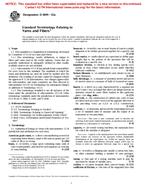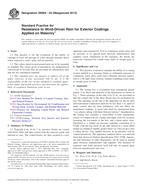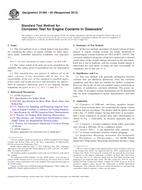1.1 This practice is intended to determine the thermal conductivity of a sheet material. This practice is not limited to leather, but may be used for any poorly conductive material such as rubber, textile and cork associated with the construction of shoes.
1.2 A constant heat source is sandwiched between two identical metal cylinders which are mounted with their axes vertical. A test specimen is placed on the top surface of the upper cylinder and a third identical metal cylinder is placed on top of the test specimen so that all the cylinders and the test specimen are concentrically aligned (see Fig. 1). The heat source is switched on and the temperatures of the three blocks allowed to reach equilibrium. The thermal conductivity of the test specimen is then determined from the steady-state temperatures of the three blocks, the exposed surface areas of the blocks and test specimen and the thickness of the test specimen.
1.3 This practice does not apply to wet blue.
1.4 This standard does not purport to address all of the safety concerns, if any, associated with its use. It is the responsibility of the user of this standard to establish appropriate safety and health practices and determine the applicability of regulatory limitations prior to use.
 FIG. 1 SATRA Lees’ Disc Thermal Conductivity Apparatus
FIG. 1 SATRA Lees’ Disc Thermal Conductivity Apparatus
Product Details
- Published:
- 04/01/2012
- Number of Pages:
- 4
- File Size:
- 1 file , 87 KB


